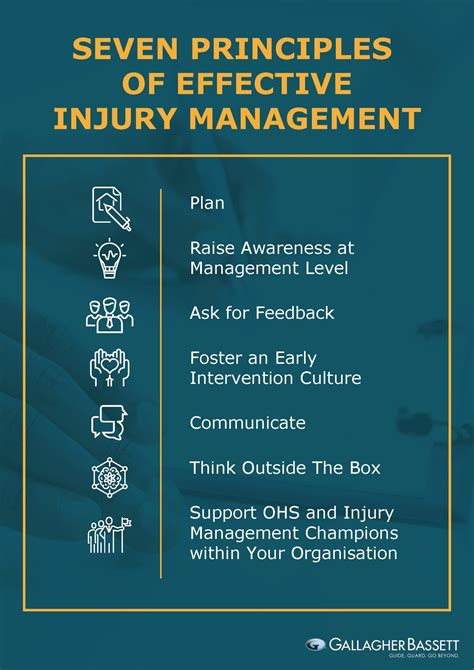Injury Management - Strategies for Recovery
Injury Management FAQ
What is injury management?
Injury management involves activities and procedures undertaken or established to enable workers with a work-related injury or illness to achieve a timely, safe and durable return to/recovery at work. This guide will help insurers establish and maintain an effective injury management program in line with:
What is an effective Injury Management Program?
In summary, effective injury management programs include early intervention, a focus on recovery at and return to work, open communication and appropriate certification. The Australasian Faculty of Occupational and Environmental Medicine (AFOEM) Australian and New Zealand Consensus Statement on the Health Benefits of Work (2011)
What is the injury management program guide?
The injury management program guide will help insurers establish and maintain an effective injury management program to enable workers with a work-related injury or illness to achieve a timely, safe and durable return to/recovery at work.
Why is injury management important?
It encourages employers and workers to look beyond simply meeting their legislative obligations in injury management, and to consider the benefits of actively embracing the management of injuries within their workplace. Returning an injured worker back to meaningful work needs more than just paper work and procedures.
What is a sports injury?
The term “sports injury” refers to the kinds of injuries that most commonly occur during sports or exercise, but they are not limited to athletes. Factory workers get tennis elbow, painters get shoulder injuries, and gardeners develop tendinitis, even though they may not participate in sports.
What is the ice method for sports injuries?
The RICE method is a common treatment regimen for sports injuries. It stands for: This treatment method is helpful for mild sports injuries. For best results, follow the RICE method within the first 24 to 36 hours after the injury. It can help reduce swelling and prevent additional pain and bruising in the early days after a sports injury.
What is an example of a sports injury?
Examples of acute injuries are sprains and dislocations, while some common chronic injuries are shin splints and stress fractures. Treatment for a sports injury depends on the type of injury, but minor ones can usually be treated at home by resting, icing, compressing, and elevating (R-I-C-E) the injured part of the body.
How can I help people with a traumatic injury?
1.5.11 Encourage people to record information about their injuries, treatments and rehabilitation therapy options (for example, using a diary as part of their rehabilitation plan) to assist discussions and shared decision making.
Injury Management References
If you want to know more about Injury Management, consider exploring links below:
What Is Injury Management
- https://www.sira.nsw.gov.au/resources-library/workers-compensation-resources/publications/workers-and-claims/injury-management-program-a-guide-and-checklist-for-insurers
- https://jobsitecare.com/blog/workplace-injury-management-guide/
- https://www.worksafe.tas.gov.au/topics/compensation/workers-compensation/information-for-workers/injury-management-making-it-work
- https://www.completeinjurymanagement.com/what-is-injury-management-and-how-does-it-benefit-workers/
- https://bccsa-web-resources.s3.ca-central-1.amazonaws.com/1696021886.pdf
- https://www.rtwmatters.org/article/article.php?id=1901
- https://www.injurynet.com.au/latest-news/effective-injury-management-a-key-component-of-all-health-safety-and-wellbeing-programs/
- https://www.nice.org.uk/guidance/conditions-and-diseases/injuries--accidents-and-wounds
- https://www.safety.uwa.edu.au/health-wellbeing/physical/injury-management
- https://lgiswa.com.au/documentlibrary/documentnew/publicindex?documentId=186&fileName=Injury_management_and_the_worker_Nov2018_web.pdf&libraryGuid=892c2b10-8544-411b-9e4e-0f6ae08c214a
Injury Management Information
- https://cks.nice.org.uk/topics/sprains-strains/management/management/
- https://www.nhs.uk/conditions/sprains-and-strains/
- https://patient.info/doctor/ankle-injuries-pro
- https://www.healthline.com/health/sports-injuries
- https://thesst.org/public-information/injury-management-guidelines/
- https://www.kch.nhs.uk/wp-content/uploads/2023/01/pl-936.1-soft-tissue-injury-management.pdf
- https://www.niams.nih.gov/health-topics/sports-injuries
Explore Related Topics
Supporting Caregivers: Resources, Tips, and Self-Care Practices
Share practical resources, helpful tips, and self-care practices to support caregivers of diabetic patients.
